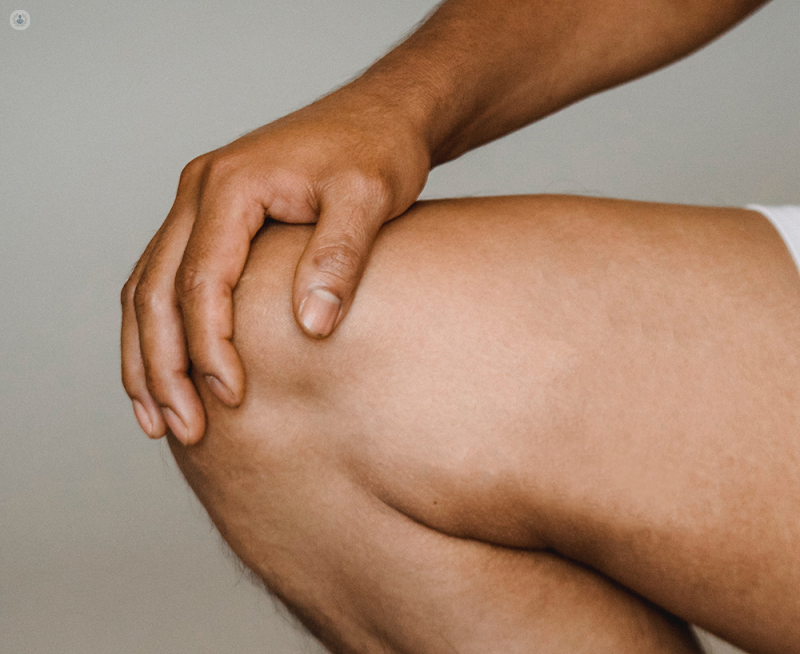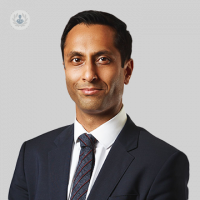Knee osteotomy: what to expect from your knee realignment surgery
Written by:If you have arthritis damage in a specific area of your knee, joint replacement surgery is often suggested. However, recent advances in techniques and a better understanding of the outcomes of joint replacement surgery have led to joint preservation surgery. This procedure allows us to take the pressure off the affected arthritic area to relieve your knee pain, instead of replacing the joint. But what does the procedure involve and how does a surgeon relieve the pressure in the knee?
Mr Raghbir Khakha, a top consultant trauma and orthopaedic surgeon based in London with the Orthopaedic Specialists group, guides us through the surgery, preparation and recovery period and explains the symptoms that indicate you may need this treatment.

What is a knee osteotomy?
A knee osteotomy is a surgical procedure that aims to relieve pressure on the arthritic part of the knee by realigning the limb and loading normal cartilage. As part of the normal arthritic process, the shape of the legs changes over time from being either “bow-legged” or “knock-kneed”.
Surgery to correct this alignment can take the pressure off the worn-out part of the joint and relieve the pain, achieving the possibility of retaining what nature has given you and maintaining good levels of activity.
The purpose of an osteotomy is to maintain the patients own anatomy, relieve the arthritic pain and maintain an active lifestyle without having to go down the route of knee replacement surgery.
Active patients often present with knee pain from arthritis and are usually advised to either wait until they are older and undergo knee replacement or have a knee replacement at an early age. The outcomes from joint replacement surgery can be variable with a dissatisfaction rate as high as 20%. Therefore, joint preservation surgery can be desirable.
Is a knee osteotomy a major surgical procedure?
Yes, a knee osteotomy is a major surgical procedure but less of an intervention compared to a total knee replacement. We are now able to do the procedure using minimally invasive techniques and state of the art implants, frequently as a day case procedure. We have been at the forefront of developing contemporary techniques to make this a safe and reproducible treatment.
Our team of surgeons from around the world are leading experts in developing and performing these types of surgeries. We frequently teach surgeons from around the world how to perform the full complement of knee osteotomies as well as running a fellowship programme for surgeons wanting to learn all aspects of knee surgery.
How is a knee osteotomy performed?
A knee osteotomy is performed using a minimally invasive approach allowing for reduced pain and a quicker recovery. A 4-5cm incision is placed on the inner border of the shin bone if it is needed in the tibia or at the end of the thigh bone (inside or outside) if the correction is needed in the thigh bone.
We utilise techniques such as allograft bone wedges for the osteotomy gap-filling to reduce bleeding and swelling. This has added to the stability of the osteotomy, reduced post-operative pain as well as reduced bleeding. We also use post-operative cryocompression to reduce pain and swelling and early mobilisation to help you quickly recover from the procedure.
How do you know if you need a knee osteotomy?
If you have pain around the knee and have noticed a gradual change in the shape of your legs (bow-legged or knock-kneed), then you may be suitable for realignment osteotomy surgery.
Age is not a contraindication, and patients who wish to avoid replacement surgery may be considered for osteotomy surgery as an alternative providing there is not widespread arthritis throughout the whole knee joint. Patients may present with pain at the front of the knee and have had a childhood problem related to the way their limbs are rotated. These patients are also potentially suitable for osteotomy surgery.
How do you prepare for knee osteotomy surgery?
Like most operations, preparation is key. We will help you to make sure that the muscles around the knee are functioning well. Often patients will have a bend in the knee due to arthritis which can be corrected through an osteotomy. This can help it to fully straighten and allow the patient to rehab properly after surgery.
We recommend hiring a cryocompression device from PhysioLab to help reduce the pain and swelling after surgery.
Our team is on hand to help guide you through the journey from booking your appointment through to post-operative care.
How long does it take to recover from a knee osteotomy?
Traditionally, patients were advised not to weight bear through the operated legs, however, due to the techniques and implants we use now, we allow patients to fully weight bear immediately after surgery.
Some people need to use crutches for the first two weeks after surgery when most of the recovery is taking place.
After the wound is reviewed at two weeks, physiotherapy can then begin. Most patients feel they have made a full recovery from surgery at 4-6 weeks.
The London Knee Osteotomy Centre is a centre of excellence for osteotomy surgery bringing together world-renowned surgeons from across Europe.
The centre was set up by leading surgeons Professor Adrian Wilson, who has a world-wide reputation for osteotomy surgery and Mr Raghbir Khakha, one of our leading trauma and orthopaedic surgeons. They are also joined by Dr Ronald van Heerwaarden and Dr Kristian Kley who are also globally recognised leaders in their specialist field.
If you would like to make an appointment with Mr Raghbir Khakha, head to his Top Doctors profile and book online.


